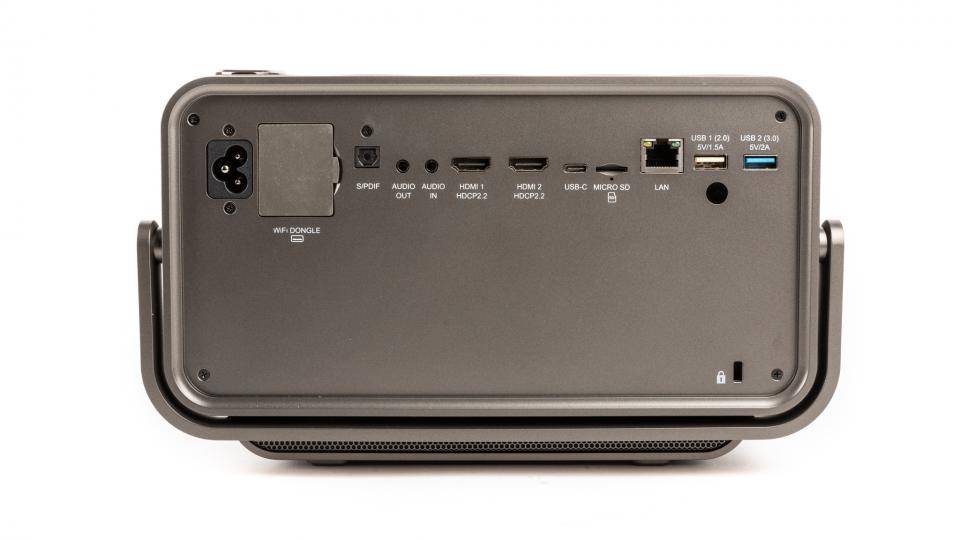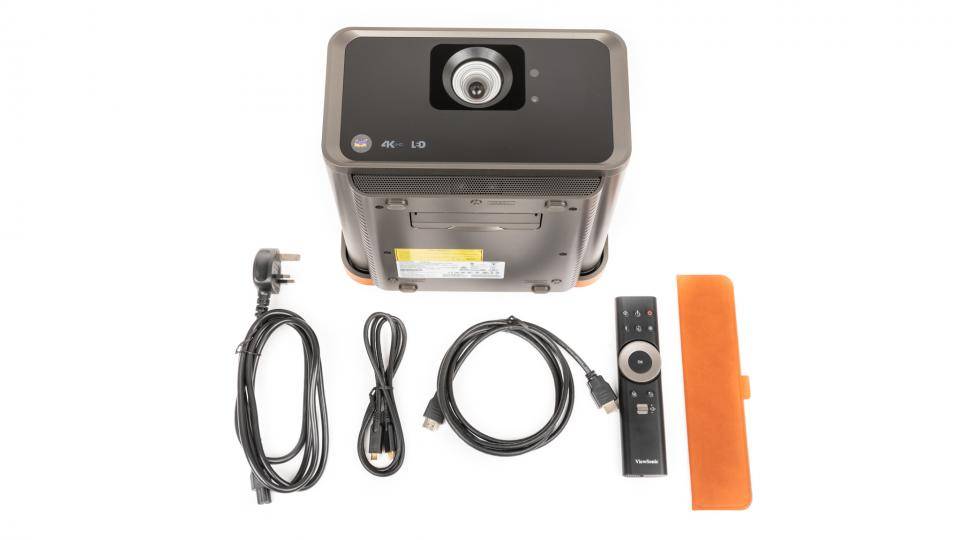January 16,2022
ViewSonic X10-4K review: A class act
by David Stewart
4K has long-since gained widespread acceptance as the de-facto standard in living rooms across the globe but while 4K TVs have tumbled down to pocket-money prices, projectors have been slow to follow suit. That’s slowly beginning to change, however. A projector such as the ViewSonic X10-4K still costs as much as a quality 55in OLED TV, but it has one killer advantage: it can expand 4K thrills to cinema-sized proportions.
At £1,300 this isn’t quite the cheapest we’ve seen – the BenQ TK800 and the Optoma UHD40 both cost less – but as a new model, that’s pretty much par for the course. And it makes up for the price tag with specifications that, in some regards, are superior to its counterparts.
READ NEXT: Our guide to the best 1080p and 4K-ready projectors
ViewSonic X10-4K review: What you need to know
As with all 4K projectors at this price, the ViewSonic X10-4K utilises one of Texas Instruments' XRP DLP chips to generate its projected images. It’s important to understand that this means it can’t deliver true 4K: instead, it projects four 1080p images in quick succession, shifting the image very slightly each time to fill in the gaps and produce the 4K image.
In truth, you probably won’t notice the difference between the image this projector can create and a “real” 4K projection, though. And there’s plenty else here to like about the ViewSonic X10-4K. For starters, it’s a portable unit, with an integrated handle and an unusually good-looking design. It has a Harmon Kardon sound system built-in, streaming media functions, Wi-Fi connectivity and even Alexa and Google Assistant support.
And, thanks to its LED light source, you can use it for much longer without having to buy a pricey replacement lamp. The Viewsonic’s LED source lasts up to 30,000 hours where the lamps in some other projectors won’t even last as long as 5,000 hours in normal use.
ViewSonic X10-4K UHD Short Throw Smart Portable LED Projector for Gaming, Family & Home Entertainment with WiFi Bluetooth and Harman Kardon Audio - Metallic Charcoal £1,230.06 Buy now
ViewSonic X10-4K review: Price and competition
Those advantages are important because, at the price, the competition is pretty fierce. For around £300 less, you have the Excellent BenQ TK800, which you can lay your hands on today for £998 . It’s a compact, short-throw projector with excellent levels of brightness, albeit not the most colour-accurate image.
For only a little more than the X10-4K, you have our current favourite projector, the BenQ W2700 , which uses the same imaging system as the ViewSonic (Texas Instruments DLP) but has a lamp-based light source that will need replacing every 4,000 hours or so. With the ViewSonic lasting a claimed 30,000 hours, that could save you up to £1,250 in lamp costs over the lifetime of the projector, or fund the purchase of another projector altogether.
Image 7 of 20
ViewSonic X10-4K review: Design
The ViewSonic X10-4K is uncommonly good-looking for a projector; the chassis is finished in an alluring dark, gun-metal grey plastic. It’s designed to be portable, too, with a handle that folds out from the rear and a leather cover that clips over the ports at the back. The handle means you can lug it from room to room pretty easily and makes it a doddle to stow away in a cupboard. It’s a bit big for lugging around on your travels, though, and weighs a substantial 4.1kg.
In terms of connectivity, there’s plenty on offer. You have a pair of HDMI 2.0 inputs for connecting your Blu-ray player and any streaming dongles you might have. There’s a USB Type-C port for streaming content from devices like smartphones and laptops, and a couple of USB Type-A ports (one USB 2, one USB 3) for plugging in USB thumb drives and hard disks.

There’s also a microUSB card slot, an Ethernet socket, 3.5mm jacks for audio input and output, one optical digital audio output and a third USB Type-A socket beneath a rubber flap for the supplied Wi-Fi dongle. With Bluetooth connectivity built-in, integrated Harman-Kardon speakers, and Android app compatibility (via the Aptoide store), the projector can be used as a wireless speaker, media streamer and smart TV in one, as well as something to watch your favourite Blu-rays on.
Alas, while connectivity is comprehensive, the same cannot be said for the physical controls on the projector. There’s a rotary knob on top of the projector, which can be used to adjust the volume, to switch it on and off, or pair Bluetooth devices but that’s your lot. Without the accompanying infrared remote control, which is also rather minimalist and doesn’t feel particularly robust, there’s no way of navigating around the projector’s menu system or switching sources.
Even when you get your hands on the remote control, however, you may wish you hadn’t because the projector’s UI and streaming apps are woeful. The graphics are huge and basic-looking and navigating around is hardly the last word in responsiveness.
After a bit of a struggle logging onto my Wi-Fi network I managed to install both the Netflix and BBC iPlayer apps from the Aptoide store, however I was warned in both instances that I was installing desktop apps and was advised to connect a keyboard and mouse. Sure enough, I was unable to log into my BBC account – the onscreen keyboard refused to fire up – and although I was able to get into Netflix, it was a real pain to use. To top it all, it definitely wasn’t streaming in 4K.
In short, if it’s streaming media facilities you want, you’re better off purchasing either a Roku Streaming Stick+ , a Chromecast Ultra or an Amazon Fire TV Stick 4K . All work much better than this system.
ViewSonic X10-4K review: Picture quality
It’s also disappointing that physical positional fine-tuning is limited, especially so since this is a projector designed to be sat on a surface that may not have been designed for a projector – your coffee table, for instance. There’s a basic flip-down leg that folds out from the bottom of the projector, allowing you to tilt the front of the machine up by either 15- or 30-degrees and nothing in between. There are no legs at the rear, either, to allow you to compensate for a slightly wonky screen or table and no lens shift facility at all.
These shortcomings are compensated for by the quality of the images the X10-4K is able to generate. First up, autofocus means the image is always sharp and crisp with no need to fiddle around with a manual focus wheel. Automatic, vertical-keystone adjustment also ensures the image remains straight, no matter where the projector is positioned, although it’s worth remembering that digital keystone adjustment of any kind will reduce picture quality somewhat.
The RGB LED light source is where the ViewSonic holds its biggest advantage over other DLP projectors. As well as an uncommonly long lamp life of 30,000 hours (that’s 7.5 times as long as the X10-4K’s rival, the BenQ W2700 ) this means there’s no need for a spinning, segmented colour wheel to add colour to the light path. The knock-on effect of this is that the projected image isn’t afflicted with the dreaded “rainbow effect” most DLP projectors induce when you move your eyes from one side of the screen to the other.
Another benefit is slightly wider colour coverage than most DLP projectors can manage. Viewsonic says the X10-4K can produce around 125% of the Rec.709 colour gamut, which is the colour space used in non-HDR movie content. According to my measurements, it reached 128%.

This isn’t quite as broad as the colour space described by the DCI-P3 standard used in HDR10 content (the X10-4K covers around 94% of that) but it’s good enough to give your 4K Blu-rays a real pop of colour. In the opening scene of The Revenant, the blood splatters look spectacularly livid against the pale white of the snow. In fact, the picture quality is generally outstanding. Choose the Movie preset, dim the lights and you’ll be rewarded with an impressively bright, colourful and vivid image.
For the most part, you can leave the projector’s settings at their default levels, but the picture’s rather limited black level (a measured 0.37cd/m2 in a completely dark room) does mean you might need to tweak the EOTF to make darker HDR scenes watchable. This allows you to lift the details in the shadows without affecting the vibrance or impact of the overall image.
Don’t, however, be tempted to tweak the frame interpolation control. Even at its lowest setting, this adds far too much of the soap opera effect for my liking, lending movie scenes a rather artificial, over-smooth look. The good news, however, is with it turned off, the projector controls frame judder very well anyway so there’s no need to use it in most circumstances.
READ NEXT: BenQ W2700 review
Optically, the X10-4K performs well, too. The autofocus system makes setup a doddle and the although the short-throw optics allow it to project an image 100in across the diagonal a mere 1.77m away from your screen, there’s barely any distortion or softness in the corners or at the edges of the image.
Lastly, the built-in Harman Kardon sound system isn’t bad, either. Inside the chassis of the X10-4K is a pair of 8W speakers and these pump out audio that’s surprisingly loud and well-filled out – much better than most projectors, anyway. For watching the odd TV show or maybe the big match they’re absolutely fine, although there isn’t much in the way of bass, so for watching movies you’ll want to connect the system to your soundbar or home theatre system.
ViewSonic X10 4K review: Verdict
The Viewsonic X10-4K is a class act. It’s neatly designed, packed with features and comes with all the connectivity you could possibly need. Lamp life is incredibly long, too, and image quality is superb.
The only caveat is that the built-in streaming system is poor, with a limited app store and barely usable apps. Remedy that with an inexpensive streaming stick such as the Roku Streaming Stick+ , though, and the Viewsonic X10–4K is a top-quality, portable 4K projector at a very reasonable price.






